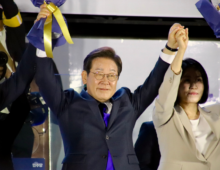|
Analysis South Korea’s eldercare crisis leaves families buckling under caregiving weightHigh costs and inadequate public support force families to shoulder the burden, leading to tragic consequences Hyojin KimMay 14, 2024  A care worker pushing a patient's wheelchair | Image: Canva South Korea’s lack of comprehensive public eldercare services and the high costs of professional care services force many families to provide care themselves, resulting in significant financial strain and, in extreme cases, the murder of dependent elderly relatives. Kim Sang-hoe, a 65-year-old noodle shop owner from Seoul, exemplifies this struggle. He endured over a decade of financial and emotional hardship while caring for his elderly mother, who recently died from cancer in 2023. Kim spent approximately $2,200 (3 million won) monthly on day and night caregivers, in addition to medical expenses, to meet his mother’s constant care needs due to her limited mobility. His caregiving responsibilities consumed his weekends, impacted his personal life and required him to work extra hours during the week to cover costs. “Without my business, I might have considered suicide,” Kim told Korea Pro. “But now I have come to the realization that I have nothing saved for my own old age.” RISING COSTS In South Korea, cultural norms and inadequate public caregiving services reinforce the tradition of family members bearing caregiving responsibilities. Even placing his mother in a specialized nursing hospital would not have alleviated the financial burden for Kim, as these facilities do not offer assistance for daily tasks, and the national health insurance plan does not cover caregiving. Only a few tertiary hospitals have 24-hour care units staffed by nurses and nursing assistants covered by insurance, but even these do not accommodate patients needing round-the-clock care. The welfare ministry cites data showing that private nursing costs for hospital-admitted patients surged to over $5.8 billion (8 trillion won) in 2018, with projections reaching $8 billion (11 trillion won) by 2024. This total, which includes opportunity costs for families providing care themselves and the expenses of hiring professional caregivers, represents more than 60% of overall nursing costs. Park Si-yeong, an activist from Civic Action for Health Care, emphasized the financial pressures driving desperate acts. “When professional caregiving is beyond a family’s reach, they often provide the care themselves, leading to further financial strain and, in some tragic instances, the murder of the dependent,” Park told Korea Pro. The Bank of Korea estimates the average monthly cost of hiring a caregiver at $2,700 (3.7 million won, almost twice as much as the median income for those over 65. This places an unsustainable burden on the children of the elderly, typically in their 40s and 50s, accounting for over 60% of their median income. The BOK predicts that the current situation will lead to increased reliance on family caregiving and could result in an economic loss equivalent to 2.1 to 3.6% of the country’s gross domestic product by 2042.  South Korean President Yoon Suk-yeol speaks during a people’s livelihood debate meeting where he suggests the use of foreign caregivers, April 4, 2024 | Image: ROK Presidential Office COST CUTTING South Korean President Yoon Suk-yeol’s proposal to employ immigrant labor to tackle the country’s urgent caregiving needs has sparked outrage among civic groups, who denounce it as a discriminatory measure against foreign workers. During a televised policy roundtable, Yoon suggested circumventing minimum wage laws through informal hiring, specifically targeting foreign students and marriage migrants as potential caregiving resources. While current legislation guarantees a minimum wage for immigrants hired through service providers, it offers no such protection for those directly employed by individuals. Yoon’s statements echo a Bank of Korea report proposing reducing the minimum wage for foreign caregivers to curb the soaring costs of caregiving services. The report emphasizes the primary drivers behind these exorbitant expenses: a severe shortage of caregivers and the burgeoning demand from a rapidly aging population. As South Korea braces for a demographic shift, with projections indicating that one in five citizens will be over 65 by 2025, the caregiver deficit is expected to escalate dramatically. Estimates suggest a staggering rise from 190,000 in 2022 to a range of 610,000 to 1.55 million within the next two decades. Kim Won-il, a visiting professor at the College of Nursing at Ewha Womans University, criticizes the government’s proposal, asserting that it contravenes the U.N.’s International Labour Organization’s anti-discrimination regulations and is ultimately unsustainable. “They are attempting to slash wages that are already woefully inadequate,” Kim said, emphasizing that the grueling working conditions and meager compensation have led to a mass exodus of caregivers from the profession. Hospital caregivers often work 24-hour shifts with only a day off each week, according to Kim. They receive minimal breaks and a daily wage between $70 and $110 (100,000 to 150,000 won), which is significantly below the legal minimum wage. Kim highlighted the alarming attrition rate within the caregiving industry, noting that less than 20% of the two million certified caregivers continue to work in the field due to the physically and emotionally taxing nature of the job. Many caregivers abandon the profession entirely, while nursing hospitals increasingly turn to ethnic Koreans from China to fill the void. Further, he pointed out that the brokerage fees imposed on foreign workers seeking employment through agencies add another layer of complexity to their already precarious job security. PERSONAL CALLING Choi Young-mi, leader of the Korea Domestic Workers Trade Union, pointed out that care workers in South Korea endure poor working conditions, a situation exacerbated by the government’s refusal to categorize them as public-sector workers. Even those certified caregivers working for the public sector are paid by the hour and can be dismissed without notice. Those hired privately, who lack certification, must handle workplace incidents on their own, without the safeguard of social insurance, Choi added. “The government is essentially pushing the caregiving service to stay in the private sector rather than recognizing and fostering it as a legitimate industry,” she said. Woo Young-bun, a former caregiver, serves as an example of the challenges faced by those in the industry. She quit her job two years ago when her first in-home care client died, finding the mental and physical toll “too much for anyone to handle.” Woo’s duties extended beyond the standard care tasks listed in training manuals. She performed some medical procedures that usually fall under the purview of nurses, worked outside scheduled hours and even arranged funeral services for her patient. “I absorbed all of my patient’s fears and feelings — her hopes, the fear of pain, the longing for death,” Woo explained. “You can’t do this job if your goal is just to make money. It has to be a calling.”  A care worker holds a patient’s hands | Image: Canva INADEQUATE CARE South Korea’s eldercare system is experiencing a severe shortage of qualified caregivers, leaving those in need of care to suffer the consequences. Professor Kim So-yoon, the chair of the Asian Institute for Bioethics and Health Law at Yonsei University, criticized the lack of required qualifications and training for 24/7 caregivers in hospitals. “Caregivers often start working the day they are hired, leading to inevitably poor care quality. Even so, they often command high wages due to the limited supply,” Kim said. While nursing homes are supported by the national insurance plan and employ certified caregivers working eight-hour shifts, they face similar issues as nursing hospitals due to understaffing. Each caregiver is assigned an average of ten patients, making individualized care nearly impossible, according to Kim. “Dependents are routinely catheterized and given sleeping pills, while rehabilitation and personalized care remain largely theoretical,” Kim said. “Patients who enter the system in relatively good health often experience a decline in their condition.” South Koreans express significant dissatisfaction with care facilities, with a welfare ministry survey indicating that 70% prefer in-home care. However, family reluctance frequently renders this option impractical. “As life expectancies reach 80 years, with roughly a decade spent in declining health, many will face this subpar level of care until their death,” Kim added. Pressured to enact systemic reform, the government announced plans in 2023 to double the capacity of 24/7 care units in tertiary hospitals, aiming to accommodate four million patients by 2027. A 1.5-year pilot project, running through 2025, will fund 10 nursing hospitals to directly employ and pay certified care workers, with full implementation postponed until after President Yoon Suk-yeol’s term. Kim from Yonsei University acknowledged the government’s policy direction but suggested exploring more sustainable solutions, such as professionalizing care workers akin to Australia’s care coordinators and adopting long-term models like Sweden’s cohabitant housing care. “The lack of home support leads to the unnecessary placement of individuals with minor mobility issues as long-term patients in nursing hospitals,” Kim emphasized, highlighting the need for a comprehensive restructuring of the care system. Activist Park questioned the effectiveness of the proposed policy enhancements, noting that existing 24/7 care units often have vacancies while hospitals remain reluctant to admit patients requiring intensive care. “My mother and her siblings rotate in caring for my ailing grandmother to manage costs. I question our ability to care for our aging parents when the time comes,” Park said. “The system’s stagnation is frustrating when clear benefits could improve life for both the elderly and younger generations.” Edited by John Lee South Korea’s lack of comprehensive public eldercare services and the high costs of professional care services force many families to provide care themselves, resulting in significant financial strain and, in extreme cases, the murder of dependent elderly relatives. Kim Sang-hoe, a 65-year-old noodle shop owner from Seoul, exemplifies this struggle. He endured over a decade of financial and emotional hardship while caring for his elderly mother, who recently died from cancer in 2023. Get your
|
|
Analysis South Korea’s eldercare crisis leaves families buckling under caregiving weightHigh costs and inadequate public support force families to shoulder the burden, leading to tragic consequences  South Korea’s lack of comprehensive public eldercare services and the high costs of professional care services force many families to provide care themselves, resulting in significant financial strain and, in extreme cases, the murder of dependent elderly relatives. Kim Sang-hoe, a 65-year-old noodle shop owner from Seoul, exemplifies this struggle. He endured over a decade of financial and emotional hardship while caring for his elderly mother, who recently died from cancer in 2023. © Korea Risk Group. All rights reserved. |











